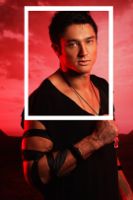Friday, April 19, 2024
News and Views from the Global South
PHILIPPINES: These Shots Target AIDS
Kara Santos

A headshot to focus on AIDS awareness. Credit: Niccolo Cosme/Project Headshot.
- A unique campaign in the Philippines is using stylised online photos to raise awareness on HIV/AIDS. Fashion and conceptual photographer Niccolo Cosme first initiated Project Headshot Clinic in 2007 as a way of merging profile photos online and advertising.
Project Headshot has partnered with various groups and sponsors to create a unique look that is used for message branding for campaigns and advertisements. After a friend in the industry came out in the open and declared himself HIV positive, Cosme took up HIV/AIDS awareness as a personal advocacy.
According to a Global AIDS Report recently released by the UNAIDS, the Philippines is one of seven nations which reported a surge in new HIV infections amid decreases in most countries worldwide. As of March 2011, six new cases of HIV were reported each day in the country, an exponential leap from the ‘low and slow’ character of the epidemic before 2007.
Department of Health figures show that in September alone, there were 253 new HIV cases confirmed and reported to the HIV and AIDS Registry, which was 65 percent higher compared to the same period in 2010.
A majority of the cases are transmitted through unprotected sex, with males within the age range 20-29 the most vulnerable. Some other cases detected have been cause by needle-sharing among injecting drug users, through mother-to-child transmission and through blood transfusion.
While Project Headshot has tied up with corporate clients in the past, they focus their campaign on the youth to raise awareness on the state of HIV/AIDS also with the support of UNAIDS, the joint United Nations programme on HIV/AIDS.
After the mass shooting activity, the photos are uploaded online for participants to use on their profile pages and social networking sites to commemorate World AIDS Day. Project Headshot makes use of a unifying symbolic design such as red paint on participant’s faces, a floating red ribbon or red frame to distinguish each year’s campaign.
This year, participants wore a whistle around their neck provided by project co-presenter The Red Whistle, a campaign that aims to “sound the alarm” on the HIV/AIDS situation though online social media effort and visual arts.
When Project Headshot Clinic for HIV/AIDS first started in 2008, participants included key trendsetters, popular celebrities, musicians, and members of the fashion industry, who were part of photographer Cosme’s network. All the photos were uploaded the same time, and everyone who participated grabbed the shots and made it their profile photo, creating immediate buzz and curiosity among those not aware of the campaign.
“You know how when you open your Facebook account and you get a notification that says ‘this many friends have changed their profile photos’ – and you see all the photos are the same. The impact is viral,” said Cosme.
In the succeeding years, Project Headshot Clinic eventually opened up slots to the public, for netizens to join the roster of pre-selected celebrities and advocates.
Previous year’s themes included “Aware” (2008) to raise awareness on the issue, “Move” (2009) to get people to do something concrete, and “Act” (2010) a call to action to get voluntary HIV screening. Currently in its fourth year, the Project’s theme for the year is “Commit.”
The highly exclusive campaign asked participants online to submit their “commitments” to help achieve UNAIDS vision: “Zero new HIV infections. Zero discrimination. Zero AIDS-related deaths.” Aside from selecting participants based on their answers, organisers assessed the number of friends potential participants had on Facebook to ensure that the campaign would have a wide reach.
Unlike traditional campaigns in print media, radio, or TV, the campaign directly embraces the youth’s inherent love for the Internet and social networking sites in an innovative way. Taking the campaign online has resulted in increased youth awareness and involvement.
“Social media tools hold huge potential to help the raise of awareness and mobilise the social action needed to turn the tide on the HIV epidemic. UNAIDS has therefore taken the best of the AIDS response – the vibrancy, the dedication, and the passion – online,” states UNAIDS on their website.
But aside from addressing establishing a strong online presence, the programme also helps raise awareness in HIV/AIDS among youth. Before the shoot takes place, peer educators from project partner Take The Test, a non-profit group which raises awareness on HIV/AIDS, gave participants a briefing on HIV in the country and explained facts on HIV prevention.
Despite years of public information campaigns on HIV/AIDS, many myths still surround it. During the pre- shoot activity, one of the participants asked if HIV could be transmitted through ‘French kissing’, which was quickly dispelled by peer educators and other participants.
According to Take the Test’s peer educators, the increase in the number of cases in the country is mostly due to the lack of awareness on the risks of HIV infection due to unprotected sex and the fear and stigma that surround HIV and people living with HIV and AIDS which often hinders people from getting tested.
The project encouraged participants to avail of the free voluntary rapid testing and counseling provided during the shooting dates. Taking the test was confidential and provided results within 30 minutes.
This would not have been possible if participants had not been lured in by the idea of getting their photo taken by a professional photographer for free and being part of a high profile awareness campaign for a good cause.
Many net-savvy participants who get involved in Project Headshot also ended up blogging about the whole experience, tweeting facts about HIV/AIDS, or sharing links on Facebook about where people can avail of free voluntary testing or preventive practices to curb the spread of HIV.

 Print
Print



